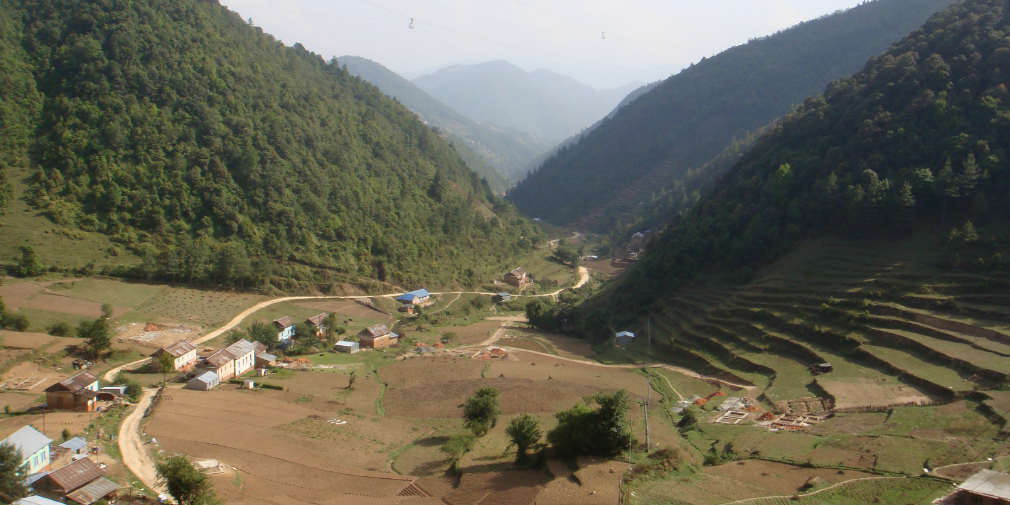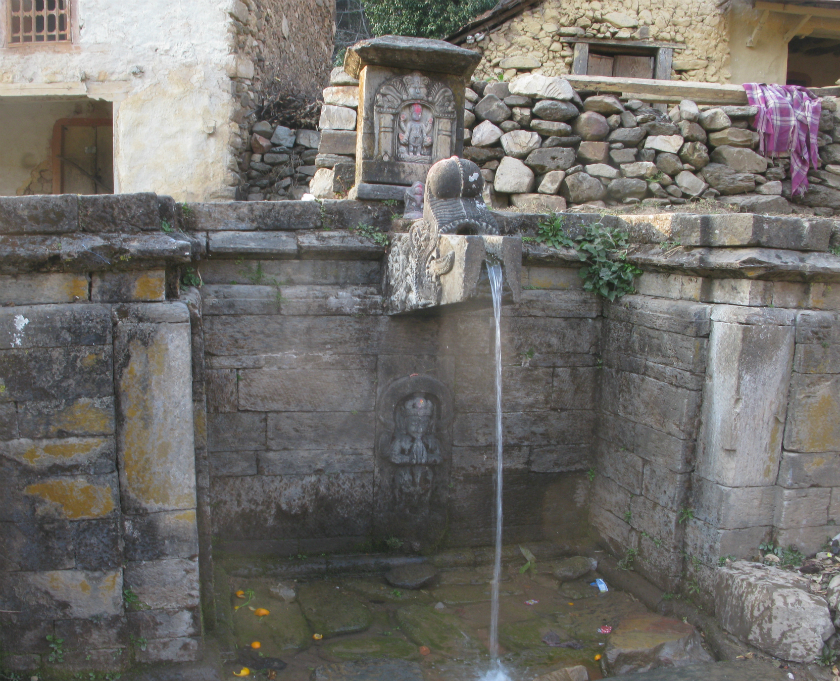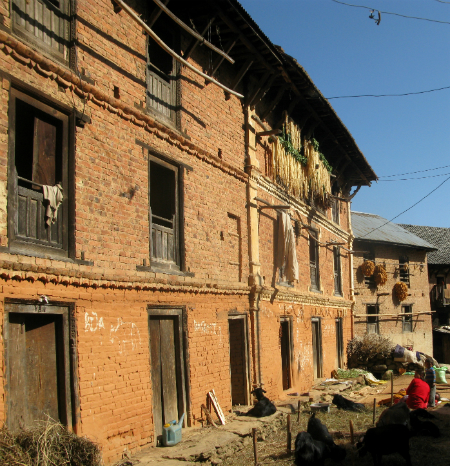
The next day, the Chitlang valley appeared verdant green in the early April morning with a glorious sun to match the country landscape. From where we stood, thick forests blanketed the hills to the North, East and the West, while to our South the view spread out into expanses of terraced field and a dirt road passing through the middle to the town. Small pockets of houses, mostly stone-roofed, were scattered around. The landscape seemed like a freshly done painting.
The forest-clad hills around was protected and looked after by the village community. The rich vegetation included: temperate varieties like pine, chilaune (needlewood), phanlat (oak), lapsi (renowned for its small fruits called hog-plum), utis (alder), and katus (chestnut). Rich in flora and fauna, the forest boasts more than 160 species of birdlife. Chitlang is also recalled for delicious peach farming.
While Shayeet left to take a stroll around, I struck up a conversation with some teachers who’d stopped for tea at the home-stay. The school was located right next to the home-stay. I learned that the old crumbling building within the school premises, which had survived the 2015 earthquake, was built by the Rana Prime Minister, Chandra Shumsher (fifth Prime Minister of Nepal, 1901-1929). Before the advent of the Tribhuwan Rajpath Highway, the building served as a guest house for Rana elites and dignitaries who stopped for the night on their journey to and from India.
After breakfast, our host, Rita Singh Thakuri, took us on a tour of her goat cheese factory. Chitlang is the first and the only village in Nepal to produce goat-milk cheese. The goat cheeses, soft and hard, sell in star hotels and restaurants of Kathmandu. We also visited the goat farm run by her and her husband, Ashok Singh Thakuri. The goat cheese has made a reputation for itself and when Chitlang is mentioned, the name of the cheese factory crops up spontaneously. Obviously, we got the chance to taste the cheese served for breakfast, yummy!
A town steeped in history
After a customary check and dusting off our bikes, we took leave on a tour of the town. First, we stopped at an old settlement called Majh Gaon, a Newar village said to be as old as the hills around. Majh Gaon housed the renowned chaitya built by Emperor Ashoka of India during his tour of Nepal during the Kirat dynasty (800 BCE–300 CE). He was on a peaceful mission to disseminate the principles of non-violence and the teachings of Buddha.
“It is believed Chitrapur (ancient name of Chitlang) was renamed Chaityalon, chaitya (monument) and lon (path) in Newari, after this monument was built. Over the years, the name got misquoted as Chitlang” said Santa Lal Newa, a 71-years old gentleman, who is an authority on the history of Chitlang. Later, I learned that he had penned a few books in Newari dialect on Newari culture and religion. “There is also a different opinion, which claims that Chitlang being very close to Patan, got its name from Chi (meaning short) and lan (path). The term Chilan is still used in Newari verses, but the first name of Chitlang was Ek Chakri Nagar, to go by the oldest history of Chitlang,” added Mr. Newa.
As we walked our bikes through narrow alleys, I was suddenly gripped with a sense of déjà vu. The surroundings seem to spark my memory that I’d seen them or been there before. Then it suddenly dawned on me that I was somewhere in the back alleys of Bhaktapur or Madhyapur Thimi.
The men and women too looked familiar — men in their suruwal (tight trousers), shirts, waistcoats, and the ubiquitous black Bhadgaunle topi (the national cap), and women in cotton checkered blouses and black fariya (traditional dress) with red borders.
Chitlang town is predominantly inhabited by the Balamis (ethnic Newars). As the legend goes, a large group of newar people from Bhaktapur for contracting smallpox was banished from the Nepal valley by the King of Bhaktapur. During that mass exodus, a child was born to a woman in the middle of a road. Myth has it that the Balamis got their name Bala (middle) and mi (person) for that reason. I spoke Newari to some and found theirs very similar to Bhaktapur’s–the reason being obvious for their origins. The accent and the diction, however, slightly differed from that of Bhaktapur.
Apart from the Balamis, Chitlang is resided by another major community of Newars called the Gamals. Curiously, this community, originally from Lalitpur and Bhaktapur, had the same fate as their cousins the Balamis. To go by the local myth, this community once served the royal kitchen in ancient Patan and Bhaktapur but was ousted for misconduct by the Malla Kings and sent to live in the villages. ‘Gama’ in Newari language translates to ‘a person from the village’ and it is speculated that the community derived its name from this word.
Since Chitlang, for the most part, is populated by Balamis and the Gamals of Bhaktapur and Patan descent, the small town hosts similar Newari cultural festivals of Kathmandu each year, the Kartik Nach (the legendary dance performed in Patan, Lalitpur in Oct-Nov), the kojagrhat dance, Bhairab and Mahadev jatra and Khadga jatra being the popular ones. Other minorities in Chitlang include Brahmin, Khas(Chhetri), and Tamangs. Some of the famous temples of Chitlang include, among others, the Kalidevi, the Swachhanda Bhairab, Bhandarkharka, and Bhimsen Mandir.

The Ashoka chaitya in Majhgaon bore a stone inscription that dated back to Sambat 45 of the Lichhavi Era (between the 5th and 8th centuries AD), proclaiming Udayadev as the king of Chitlang. I’d like to relate a small incident that took place at the chaitya site, quite a hilarious one. Before setting out on our trip, I happened to look up on the Internet for some info on Chitlang. In one of my researches, a website clearly mentioned that next to the Ashoka’s Chaitya or Stupa, Ashoka also built a metal pillar that stood nearby.
To my great consternation, I could not find one although both Shayeet and I looked all around. Just then I spotted one local guy sitting by the stupa smoking a cigarette. I approached him and asked, “Bhai, where is the Ashoka’s pillar located, I can’t see it around here.” The guy first looked me up and down and gave me a quizzical look. I’d to repeat my question again. “What pillar,” he asked sounding irritated. I repeated again and this time he really went mad at me. “What on earth are you talking about? I was born and brought up here and I know nothing or even heard about a pillar” retorted the guy rudely. I chose to back off. Mind you, the info on the Internet can be misleading at times!
Next, we visited the perennial Sat Dhara (literally, the seven stone waterspouts)—the main source of water to a number of settlements in Chitlang. The water spouts, however, had completely dried up after the 2015 earthquake. The site was overgrown with weed and wild grass and looked abandoned.
We left Majhgaon, and pedaled up to Gurujudhara, located at Tagatar. The ancient stone spout calls to mind the great poet, Laxmi Prasad Devkota, who penned his poem Yatri (traveler) sitting beside Gurujudhara while he was in Chitlang. Right next to the spout a path led down, which was a part of the old walking trail of the yore. “That path bustled with life and trade in the village flourished in the old days, before the Tribhuwan Rajpath came,” said Buddha Ratna Manandhar, a retired school head-teacher who also runs a home-stay facing the renowned stone-spout.

We rode the ancient trail a little way down, which eventually met with the main motor road. In fact, we intercepted the old footpath at several places while riding around Chitlang. We stopped at Narayanhiti, named after a shrine of god Narayan (Bishnu), a stone spout close by. The place was in shambles–a bleak aftermath of 2015 earthquake. The place needed a complete reconstruction. We continued past quaint little dwellings at Tupikhel and Kushlechour; a small rivulet called the Chitlang kusi (river in Newari) ran a little down the road to our left.
Next, we pedaled uphill to see the reputed Shivalaya way uptown to Mathilo Pauwa on the way to the Chandragiri heights. While looking at the Shivalaya completely finished in stone bricks, I was reminded of the Krishna Temple, Lalitpur. The interior of the temple was even more awe-inspiring. What struck me most was the roof–all carved in stone, which spiraled up in some kind of a geometrical pattern–a unique specimen of ancient architecture.
Toukhel
After lunch, we rode to Toukhel, another town renowned for ancient inscriptions and relics. We stopped on the way by the ruins of the historic kot (fortress) built by the Malla Kings (10th–18th century)—only old bricks and some artifacts remain. Toukhel (6 km from Chitlang), is predominantly resided by the Gopalis, yet another ethnic Newar community. I could not understand a word of it when I heard them speak. The Gopali dialect is different from the Balami or Gamal tongue—and not is only remotely close to Kathmandu or Bhaktapur Newari.

The Balamis, Gamals and the Gopalis, all Newars, live in such close proximity, but when it comes to their language, they are way apart.
We happened to meet a teacher at the local school, Rudra Gopali who volunteered to take us around the village. Toukhel (‘tou’ big and ‘Khel’ a big ground (in Newari) is exclusively resided by the Gopalis. “We are the descendants of the Gopal era (before 300 A.D.) and milkmen or cow herders by origin,” informed Rudra.
Life in Toukhel seemed laidback and timeless. Men and women going their way with their kodalis (digging tools) and dokos (conical-shaped dry bamboo strip hand-woven baskets), rice paddy laid before the houses to dry in the sun, bunches of chilies, corn-cobs and strips of sliced radish hanging by the roofs and buffaloes masticating by the neat piles of straw. For the second time that day I was reminded of being not in Toukhel but somewhere in Bhaktapur or Thimi.
Next, Rudra took us to an ancient stone inscription dating back to the Lichhavi era. “The Gopalis originally belonged to the forests. The letters on the inscription were an appeal made by the Gopalis to King Amshuverma (6th century AD) to move their residence to Toukhel instead of the dreaded forests. It is also said that King Udaya deva (621 AD), the then King of Chitlang, donated the present land to the Gopali community,” said Rudra.
Nearby villages to Toukhel included Bisingkhel, Nhulgaon, and Kunchhal. As our tour neared its end, Rudra pointed to a distant clump of trees, which he explained was the jaitun (olive) plantation and oil extraction center, the Himalaya Plantations Pvt. Ltd., a Nepal-German joint venture, set up in 1994. We wanted to see the factory but it was already late in the evening and the visiting hours were over. We thanked Rudra and left for Chitlang.
Next morning, after a ceremonial tika and a garland from the host, Rita Singh Thakuri at the homestay, we bid her goodbye and set out on our mountain bikes on the long journey to Kathmandu with a treasure trove chock-full of ancient history of Chitlang and fond memories of the trip to cherish back home. Last but not least, we felt proud to have spun our wheels on the historic Rolls Royce trail.
__________________________________________________________________________________________________
The Kathmandu-Phakhel-Kulekhani-Markhu-Chitlang circuit is a well-used track by mountain bikers (130km). Recent times have seen hikers both foreign and Nepali frequenting the route via Thankot to Chitlang). Buses and public jeeps are available on Phakhel-Pharping, and Chhaimale-Dakshinkali road. For hikers, motorbikers and mountain bikers, the route to Chitlang from Thankot is the shortest (27km). For accommodation, basic lodges, modern resorts, home-stays, tea houses and eateries are plenty to be found in Chitlang.
According to the Tourism Board, Chitlang is gradually turning into a tourist hub, drawing over 1,000 domestic and foreign tourists every week. The recent operation of cable-car to the Chandragiri heights has also helped boost tourism in Chitlang. From the Chandragiri heights, it’s like a 45-minutes downhill hike to Chitlang.
mansinghravi@gmail.com
Also read:
























